Gerakan Masyarakat Sadar Zakat
DOI:
https://doi.org/10.59059/jupiekes.v3i2.2398Keywords:
Zakat Aware Community Movement, Ta’zir, PublicAbstract
The Zakat Aware Community Movement is an initiative to raise Muslims' awareness of the importance of zakat as a religious obligation and socio-economic instrument. The goal is to encourage people to pay zakat, both zakat mal and fitrah, correctly and on target to help the poor and reduce poverty and social inequality. Zakat not only has spiritual value, but also a strategic role in welfare distribution. Awareness of zakat is expected to counter consumptive behavior or hedonism, which in Islam is known as israf (excessive) and tabdzir (wasteful). The concept of “mâl” (wealth) in Islam is everything that can be legally owned and utilized, such as houses, money, gold, and others. Blessed wealth is wealth that is obtained lawfully, benefits others, and is used to get closer to Allah. Islam also pays great attention to poverty, which is described through the terms fakir and miskin. For this reason, zakat as the third pillar of Islam has a major role in overcoming it. For those who are reluctant to pay zakat, Islam recognizes the punishment of ta'zir - a punishment imposed by the ruler to safeguard the public interest. Finally, zakat that is paid consciously and sincerely can bring blessings to wealth, strengthen social solidarity, and strengthen the economic resilience of the people.
References
Adi, K., Kurniadi, et al. (2023). Perilaku hedonis dalam Al-Qur’an: Studi atas term al-israf Q.S Al-A’raf ayat 31. Al-Mustla: Jurnal Ilmu-Ilmu Keislaman dan Kemasyarakatan, 5(2). https://jurnal.stainmajene.ac.id/index.php/almutsla/about
Aeni, N. (2021). Respon agama terhadap kemiskinan: Perspektif sosiologi. Jurnal Sosiologi Agama Indonesia (JSAI), 2(1). https://doi.org/10.22373/jsai.v2i1.1260
Afrina, D., & Achiria, S. (2018). Rasionalitas muslim terhadap perilaku israf dalam konsumsi perspektif ekonomi Islam. EkBis: Jurnal Ekonomi dan Bisnis, 2(1), 23–38.
Bulqia, M., Muhammad, R. A., & Din, M. (2015). Pemidanaan terhadap pelanggaran zakat: Kajian terhadap Undang-Undang Nomor 23 Tahun 2011 dan Qanun Aceh Nomor 10 Tahun 2007. Jurnal Ilmu Hukum Pascasarjana Universitas Syiah Kuala, 3(4).
Chaniago, S. A. (2015). Hukum dan pemberdayaan zakat. Jurnal Hukum Islam (JHI), 13(1). http://e-journal.stain-pekalongan.ac.id
Choirunnisak. (2017). Konsep pengelolaan kekayaan dalam Islam. Islamic Banking: Jurnal Pemikiran dan Pengembangan Perbankan Syariah, 3(1). https://doi.org/10.36908/isbank.v3i1.74
Enghariano, D. A. (2022). Pembacaan Wahbah Az-Zuhaili terhadap term mubazir dalam kitab Al-Tafsir Al-Munir. Al-Fawatih: Jurnal Kajian Al-Qur’an dan Hadis, 3(1), 1–15. https://doi.org/10.24952/alfawatih.v3i1.5600
Fiqri, Y. Y. (2023). Mengelola harta (al-mal) dalam perspektif Islam. Al-A’mal: Jurnal Manajemen Bisnis, 3(2). http://www.ejournal.an-nadwah.ac.id
Fushshilat, N., Andreansyah, F., & Firdaus, L. A. (2024). Manajemen zakat dan wakaf. JBEP: Jurnal Bisnis, Ekonomi Syariah, dan Pajak, 1(2). https://doi.org/10.61132/jbep.v1i2.167
Ismail, M. (2019). Hedonisme dan pola hidup Islam. Jurnal Ilmiah Islamic Resources FAI-UMI Makassar: Pendidikan, 16(2), 164–174.
Ismail. (2020). Kemiskinan perspektif ekonomi Islam. ESA: Jurnal Ekonomi Syariah, 3(1).
Nasution, J. (2017). Analisis pengaruh kepatuhan membayar zakat terhadap keberkahan. At-Tawassuth, 2(2).
Nissa, S. A., Faridah, F., & Murdianto, M. (2024). Konsep hedonisme dalam Al-Qur’an: Perspektif tafsir Al-Maraghi. Hamalatul Qur’an: Jurnal Ilmu-Ilmu Al-Qur’an, 5(2). https://jogoroto.org/index.php/hq
Razali, R. (2020). Perilaku konsumen: Hedonisme dalam perspektif Islam. JESkaPe, 4(1).
Yasin, A. H. (2016). Panduan zakat Dompet Dhuafa. Jakarta: Dompet Dhuafa Republika.
Downloads
Published
How to Cite
Issue
Section
License
Copyright (c) 2025 Jurnal Penelitian Ilmu Ekonomi dan Keuangan Syariah

This work is licensed under a Creative Commons Attribution-ShareAlike 4.0 International License.








